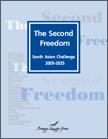Emerging Africa: China�€™s Trade based approach
|
|
February, 2012
By
|
The 18th African Summit recently held in Addis Ababa, Ethiopia saw the inauguration of an African Union Conference Centre in Addis Ababa �€“ a USD 200 million gift from China marking the Africa-China economic and strategic relationship in stone. To understand the motivations behind China�€™s generous gift to the African Union one must take a closer look at Africa�€™s current economic scenario.
Some of the fastest growing economies in the world are African with 11 African nations�€™ economies booking an average of 7% annual growth, of which three are growing at a remarkable 10% pace on average. While cheap access to electricity could well boost Nigeria�€™s 9% growth into double digits, improved governance in Ivory Coast could enable it to emulate Sierra Leone�€™s 10% annual growth rate, according to Charles Robertson, Global Chief Economist at Renaissance Capital. Robertson further attests that such rapid economic growths show that the bottom billion is becoming the fastest billion. Africa�€™s GDP will jump from USD1.6 trillion to USD 2.6 trillion by 2020, African consumer spending will be USD 1.4 trillion and 128 million African households will have discretionary spending according to a 2010 Mckinsey Global Initiative report.
Rapid economic growth is complimented by a decrease in foreign aid dependency. Ghana has reduced its dependency on foreign aid from 46 per cent to 27 per cent whereas Mozambique has reduced aid dependency from 74 per cent to 58 per cent. Also Rwanda, which is considered the most foreign investment friendly and least corrupt economy to venture in, has gone from an 86 per cent aid dependency in 2000 to 45 per cent in 2010, as reported by IPS. The secret to rapid decrease in aid dependency and economic growth, according to ActionAid lies in free aid �€“ aid without restrictions or attached guidelines The West has provided aid while requesting governments to address advocacy of anti-corruption and democracy, and recently gay rights. Infrastructural development and increase in private sector development as well as public-private partnerships are developing rapidly in Africa and thus facilitating an export-friendly, service enabled economic environment that is attracting FDI from around the globe.
Such revenue base shifts have also been noticed in Uganda, Tanzania and Kenya. For instance, Uganda has used aid to develop infrastructure such as telecommunications, construction industry, and expansion of financial institutions. These sectors are dominated by private investors and are accounting for 54 percent of the GDP, thus reducing dependence on revenue from the agricultural sector which contributes 24 percent. While its growth has been reportedly donor-driven, it continues to be the chief foreign private investment attraction in East Africa. Kenya has also used aid for infrastructural growth, particularly real estate advancement. Kenya is taking advantage of increasing presence of private companies, such as private banks and telecommunications industries for taxation to add to the country's revenues to further reduce reliance on aid. Tanzania has been the leading recipient of development aid in the region but private public partnerships are helping the country generate finances to reduce dependency on aid as well. These partnerships include the Southern Agricultural Growth Corridor of Tanzania (SAGCOT), a private- public agribusiness partnership meant to support small farmers. Economic analysts predict that the ongoing private-public partnerships in Tanzania will make the country more self-reliant.
As 60% of the world�€™s total arable and uncultivated land is in Africa, a land investment rush is being fueled by chiefly foreign private investors to whom governments are contracting out land by thousands of hectares. Buyers include but are not restricted to Chinese, Indian and Saudi investors. The possibility of Africa being the next global food basket is becoming increasingly probable with rice plantations being the number one choice of crop along with maize, sugarcane and tea. The possibilities for human development in Africa benefiting from resulting industrial and infrastructural development can be exponential.
Moreover, the energy-starved continent is expected to be the recipient of a rapid increase in foreign direct investment in renewable power at an astounding 1,583 percent increase in nine years. Investment in the renewable energy sector is expected to go up from USD 3.6 billion in 2010 to USD 57 billion by 2020, as reported by Frost & Sullivan in August 2011. The key growth sectors will be energy and power infrastructure with special focus on wind power, solar power and geothermal power.
While China�€™s economy would certainly benefit from mineral-rich infrastructural developing Africa, Africa has much to gain from diversifying its exports market. Thus it is no small wonder that China is signaling greater expansion in investments and increasing its foray in Africa which is now considered the fasting growing continent. China is not alone to place importance on this year�€™s African Summit. African Union�€™s Chair person Mr. Jean Ping received delegates from India, Japan, Luxemburg and Georgia ahead of the Summit as well.
But the most important development in Africa would not be China�€™s increasing foray in Africa. Rather it is African Union�€™s declaration to increase regional self-sufficiency and thus reduce dependency on financial crisis-ridden Europe, USA and the potentially detrimental impact of a global financial crisis on emerging market economies such as China and India. African Union this year announced the endeavor to chart out a comprehensive free trade zone across Africa to attract FDI and to increase trade alternatives against the backdrop of the global financial crisis. For example, negotiations to merge Common Market for Eastern and Southern Africa (COMESA), East Africa Community (EAC) and South Africa Development Community (SADC) into one free trade zone are ongoing. Such a free trade zone will increase Africa�€™s ability to attract foreign investments.
Africa�€™s rapid economic growth and increasing focus on trade with China and other Eastern emerging economies indicates an important shift from an aid-based approach to development issues to a trade-based approach on mutually beneficial cooperation. China has been the focus of much media attention, particularly the Western hemisphere�€™s shift in strategic focus from Middle East to South East Asia. An advancing China in South East Asian waters have sparked concerns in USA who has taken counter measures such as opening a marine base in Australia, and increased top diplomat meetings signaling closer ties with Vietnam, South Korea and Burma. However economic and strategic developments in Africa suggest that genuine potential for both international competition as well as cooperation is trade focused not military based and centered around Africa in particular, a continent which has been declared both hopeless and rising by the Economist.
Related Publications
-
.jpg&maxw=50)
Big Questions of Our time: The World Speaks, 2016
Download:Big Questions of Our time: The World Speaks _Full Report
-

-

Second Freedom South Asian Challenge 2005-2025, 2005
read more
Download:Second Freedom South Asian Challenge 2005-2025 Full Report
Related latest News
Related Conferences Reports
-

Global Challenges Conference, October 2016
Download:Global Challenges Conference Report
-

Conference on Responsibility to the Future: Business, Peace and Sustainability, June, 2008
Download:Global Security and Economy: Emerging Issues


